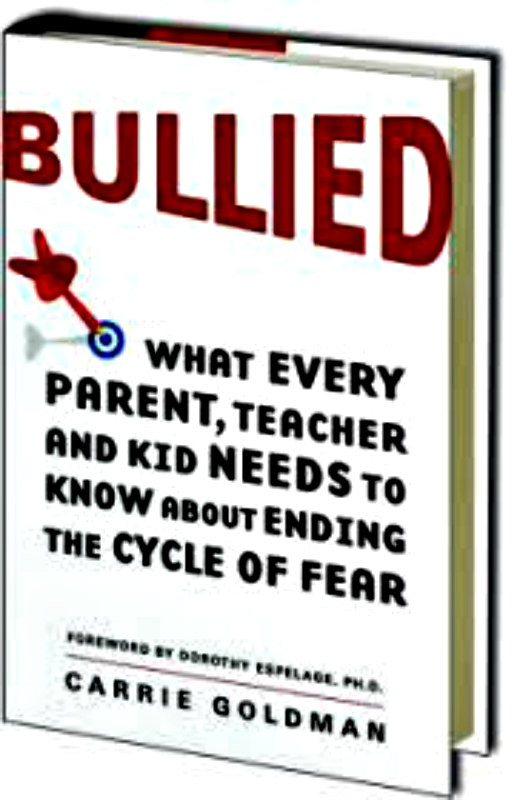BOOK REVIEW: Bullied: What Every Parent, Teacher, and Kid Needs to Know about Ending the Cycle of Fear
The 2013 Gold Winner and National Parenting Publications Award winning book, Bullied, by Carrie Goldman, is the subject of this review, in light of an increasing
awareness of bullying in our society, as well as a more directed approach toward addressing the situation. “The media has created a sense of urgency around bullying, and parents are desperate to protect their children”. Bullying includes cyberbullying, with a rising number of children reporting online bullying. This book was written as a guide for parents, teachers, and children, both the victims and the bullies, with the resounding message, “You are not alone.” (Goldman, Introduction)
The book was penned by Goldman, the mother of Katie, and the book begins with her story of being bullied in the 1st grade. Her blog went viral, and many other parents and even children’s stories are featured in the book, as evidence of the pervasive problem. Goldman discussed the fact that if comments are negative and unwanted, the taunting is repeated, and there is an unbalance of power, then that is bullying and not just normal relationship difficulties.
Goldman writes of the kids who are at high risk for peer victimization, writing that it is a “society-wide problem” that those children do not feel that they fit in. She admonishes parents for the examples they often set, making appearance a priority or speaking disrespectfully to others and about others. “Children absorb verbal and nonverbal messages from their parents. Every time we judge others, our kids are watching and learning from us”. (Goldman, p. 116) She encourages parents not to let their judgments about clothing, appearance, and social standing influence their children, but to remain open and empathetic, keeping the lines of communication open. This is true for parents of the victims, as well as for the parents of the bullies. Bullying is often ignored or minimized as “kids being kids”. Many children feign illness to stay home, often choosing to do poorly in school rather than attend or call attention to themselves.
As a former teacher, during the reading, I was called to note the subtle bullying behaviors kids use and I am sure I was guilty of letting something slide that should have been addressed. Goldman writes of the continued pushing and shoving, name calling, and even just the isolation and not being chosen as ways that children are
subjected to bullying numerous times a day. Now with cyber-bullying, the taunts follow them home, and the victims are often shamed into not telling.
Cyber bullying can take many forms, from sexual harassment, to slander, to groups ganging up and bombarding the victim online, quickly spreading malicious and
hurtful comments, often taking pleasure when the victim tries to retaliate. Schools are often reluctant to get involved, but if the behavior disrupts the learning environment, effectively coming into the school, then schools must become involved, according to Goldman. Sexting and sexual cyberbullying also fall into that category, which falls under the Title IX discrimination, so schools must address the problem. In the case of sexual harassment, police should be contacted.
The effects of bullying are ongoing and chronic, with children who were victims often experiencing depression and anxiety well into adulthood. Many develop health related symptoms, as well as fears of being in crowds and other social phobias and performance related anxiety. Low self-esteem and difficulty communicating, as well as compromising trust are just a few symptoms. In the bullies themselves, if unaddressed, they continue, often becoming demanding, aggressive and abusive into adulthood, often becoming bosses who abuse their power, with no empathy toward others. Goldman also writes of “bullycide”, when the bullying leads to a person taking his/her life. “Bullycides occur when victims can no longer endure the psychological effects of being bullied”. (Goldman, p. 105) Many of these children have endured terror for years, with no one stepping in, with no hope in sight. Often they feel that no one will listen if they tell, or nothing will be done, or that the degree of the bullying will only increase, so they sadly see no other way out.
Goldman does have suggestions within the book to help parents, both the parents of the victims and of the bullies. “When parents are heavily concerned with social status, it has a chilling effect on a child’s willingness to report peer victimization”, writing that “if you place a high value on popularity, your child will be reluctant to talk with you about social problems”. (Goldman, p. 128-129) The author offers suggestions for family guidelines, technology use, music and media. She also has suggestions for toy makers, with “boy” and “girl” labels, which often begin the gender bullying. She also calls into question our cultural attitudes about aggression and cruelty, strategies to ease the negative effects, as well as how to support victims rather than minimizing or outright ignoring.
The last third of the book includes resources, (online, book, and audiovisual) as well as a list of research-based bullying prevention programs and character education programs. There are also two bullying surveys and some examples of sexual harassment surveys to help those adults who are called to step up to guide our children.
Goldman suggests that it is necessary to tell our children, “Feel whatever you want. But you can’t do whatever you want”. (Goldman, p. 130) All who are involved, the bullies, the victims, and even the bystanders who often feel guilty about doing nothing, are human and we need to look at how we help people move forward to accepting everyone as they are, as they look, focusing on the beauty within.
Works Cited
Goldman, Carrie. Bullied: what every parent, teacher, and kid needs to know about ending the cycle of fear. 2012. HarperCollins Publishers, NY, NY
Tags:
bullied at school,
cyberbullying,
parent responses to bullying

